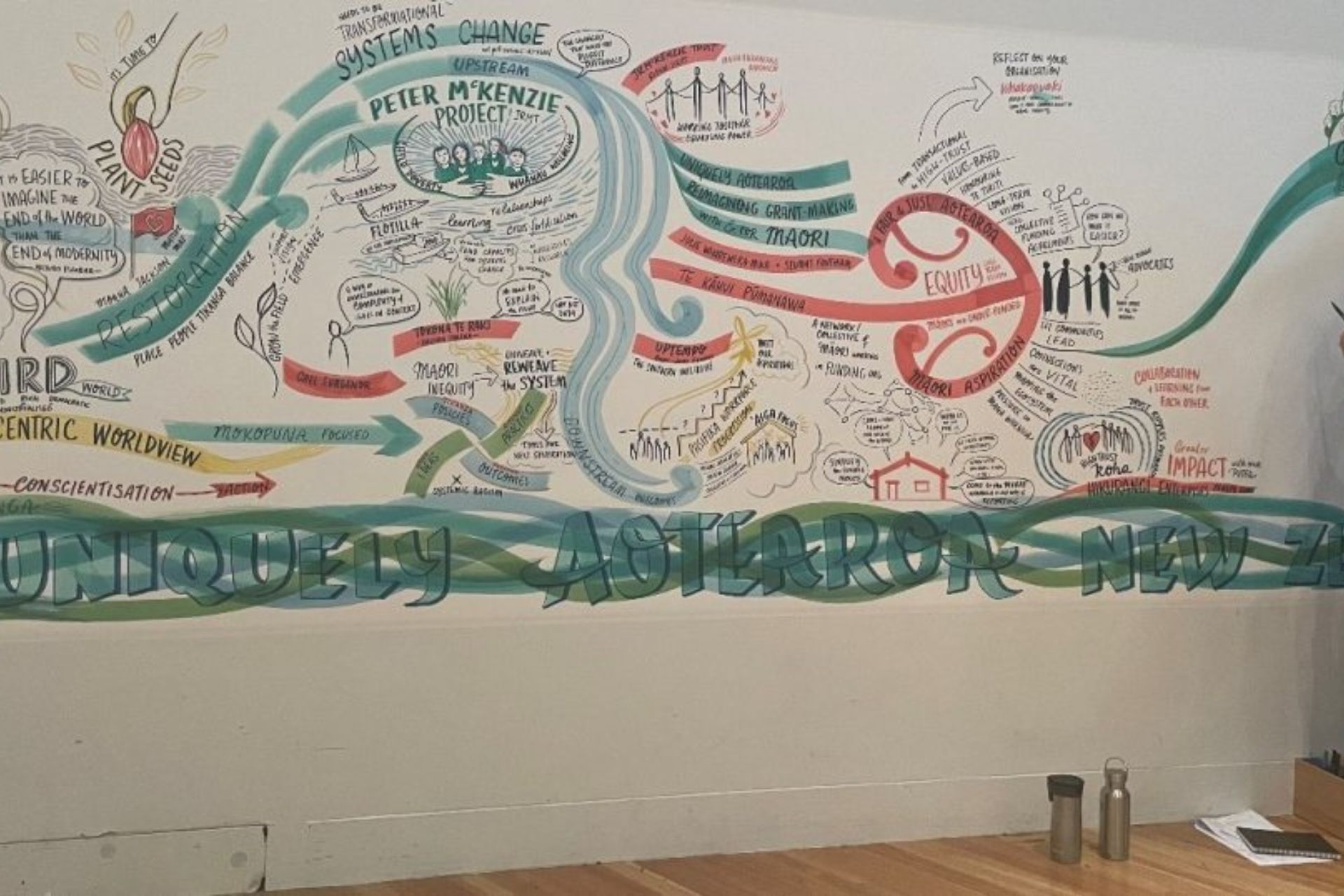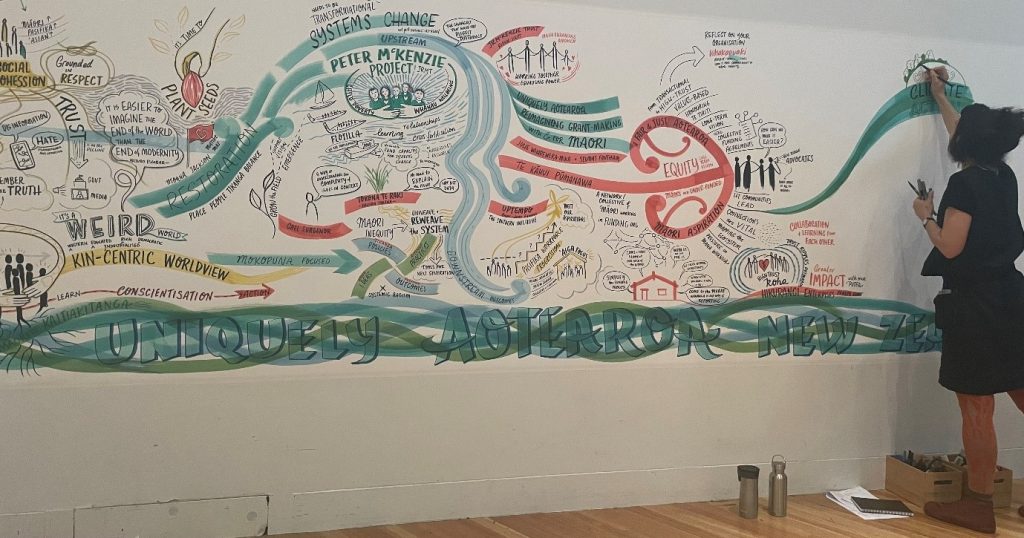Key takeaways from the 2023 Philanthropy New Zealand Conference from Jo Garner, Ruth Button and Greta Buchanan.
“There comes a point where we need to stop just pulling people out of the river. We need to go upstream and find out why they’re falling in.”
It was these words, by Desmond Tutu and quoted at the 2023 Philanthropy New Zealand Conference, held in Wellington, Te Whanganui-a-Tara, that really did encapsulate the key messages throughout the main themes of the conference, of governing for change, equity, climate action, and creating systems change.
Team NZ and I loved our attendance in every way—from catching up with valued clients and partners, to learning, joining and contributing to the dialogue on how we can all collaborate and work as allies to help create the systems changes that are needed to address the issues affecting sustainable and thriving communities.
Held in the week that marks Te Wiki o Te Reo Māori, 51 years on from when the Māori Language Petition was presented to Parliament on 14 September, 1972, it is always so refreshing and a little confronting to me, (as an Aussie about to vote YES for our own Constitutional amendment, the Indigenous new chapter, Chapter IX-Recognition of Aboriginal and Torres Strait Islander Peoples to the Constitution), that while still a way to go in NZ, Indigenous voice is very present and very much a part of government, corporate and community.
There is a lot to be learned from our friends across the Tasman! Which takes us to the several key messages that were presented and showcased as impact in action.
Equity is a process
We heard from the Peter McKenzie Project, a key programme of the JR McKenzie Trust, which is a collective of initiatives tracking the root causes of child and whanau poverty in Aotearoa New Zealand. It very much acknowledges the fact that there is not going to be one submission / project that has an answer that is complete. The problem is big and needs to be tackled collaboratively.
Tokona te raki is one of the funded partners who focus on the solutions being woven into the policies and practices, through ideas coming from consultation, which is the basis of their work. These graphics represent not just the messages from this session, but from the conference, overall.


“Our work is likened to Raki Tukutuku. The heavens were woven and bound together like the tukutuku panels of a marae. Our work often involves unweaving and unlearning old ways to loosen the bindings so that change and growth can emerge. Once new horizons are set then the task is to reweave the bindings so that the tokotoko are tightly connected and supporting one another – kia tukutuku anō ai te Raki.”
Source: https://www.maorifutures.co.nz/
The partnership looks at how do we shift from those short-term programme funding initiatives to long-term systemic change. Inequity for Māori needs to look at human behaviours, systems, societal narratives and policies. You can’t just lead with data and logic as that is liable to be interpreted differently depending on each individual’s perspective/lens.
The upstream causes of the problem need to be interrogated. It is acknowledged that there needs to be a movement away from just doing a bunch of pilot projects. With longer-term infrastructure funding, the funder’s trust and confidence in the funding agreement gave the iwi confidence. The initiative is an exemplar in partners (funder and grantee) committing to hold hands to go on that journey together, giving the organisation breathing space to move away from short-term outcomes to look at the tools and the processes needed to create long-term, sustainable solutions.
Summed up beautifully by Robyn Scott, Executive Director of the JR McKenzie Trust:
- What have we learned over the past 12 months. What supports upstream change?
- Funding people
- Nourishing changemakers
- Wairua connection spaces
- Values alignment
- Equalize power including people who are from the groups we are working with
- Funding was more flexible. Still with checks and balances but more flexible approach and shifting focus of power. There needs to be space to allow the partnership to be transformational for both our partners and our iwi
- Equity / Adaptability / Learning
From the wellbeing of humans to the wellbeing of our climate and environment—like all big solutions, the work needs to have whanau and community at the centre, especially when there is so much knowledge to be gained from our Indigenous communities, their whakapapa or ancestry, and their strong connection to the land and the natural world.
Solutions require collaboration
Again, the systems change towards solutions require collaboration. Government / law makers, local government planning, local community knowledge and expertise, and philanthropy. And while economic models of climate change and effect on corporate were presented, the very important questions were asked: how can we get to a middle ground of understanding that the wellbeing of humans, is dependent on the wellbeing of our planet, and, given the increasing rate of environmental events, what is the best space for philanthropy and grant-making during the emergency and the response?
Talking about community relocation when natural disasters impact the community, Joyce-Anne Raihania, Ministry for the Environment, spoke about the work she led in 2018. Joyce-Anne was privileged to work alongside her whanau and the Huramua community in Wairoa with the repatriation of their whanau and ‘taonga’ from the Mātiti Urupā due to the Wairoa River erosion, with the help of funding from JR McKenzie.
The Mātiti Urupā was located close to the Wairoa River, and their buried whanau and taonga were slowly being washed away as the river’s waters expanded each year. A recent visit to Mātiti Urupā highlighted the forward thinking by the whānau and community to have moved their whanau and ‘taonga’ as trees that were planted there after the repatriation were all lost due to the damage caused by the recent cyclone.
The values discussion was a central theme. Who is vulnerable, what is vulnerable? What and how will things change? How will we know? All questions for community, philanthropy and government to ask and work together. There must be consensus and all voices must be heard equally, for real and lasting change.
How do we want to be remembered?
One of the closing summary statements encapsulated the conversation and learnings perfectly, from Lani Evans, recently appointed Programme Director at the Aotearoa Foundation:
We have to keep learning, be great allies, and celebrate progress. The best question we can ask ourselves is, what kind of ancestors do we want to be? How do we want to be remembered?
This is why I love working in and for the for-purpose sector and all the organisations with a Mission to create better, stronger, sustainable solutions. Let’s hope that in Australia, on October 14th, that our Indigenous ancestry is acknowledged in the way it should have been many years ago, to give Voice to the Indigenous peoples of the land on which we live.

